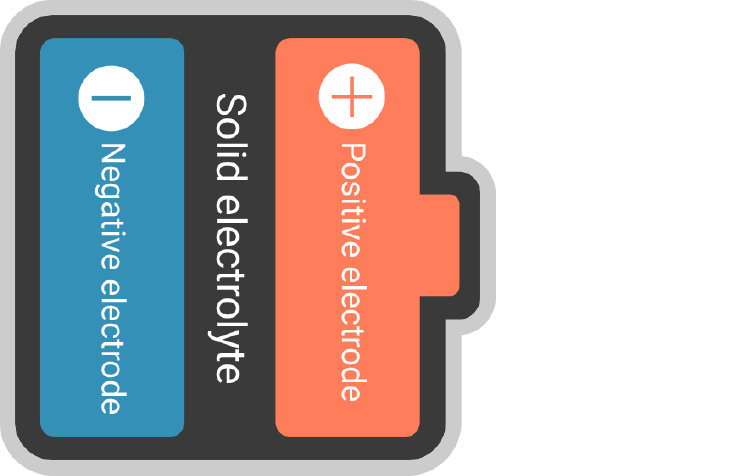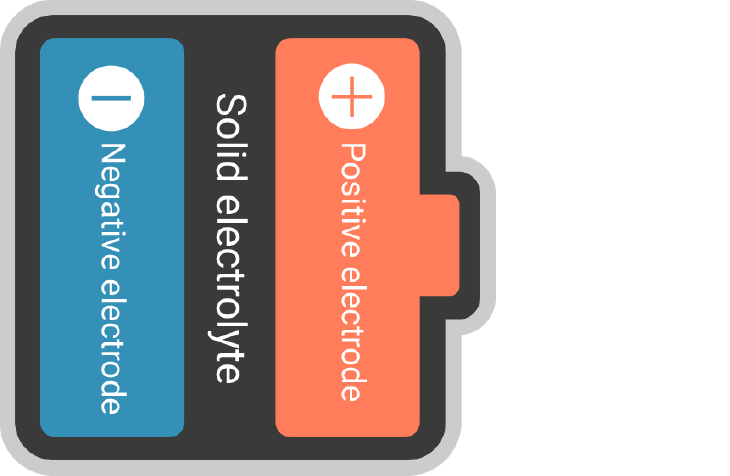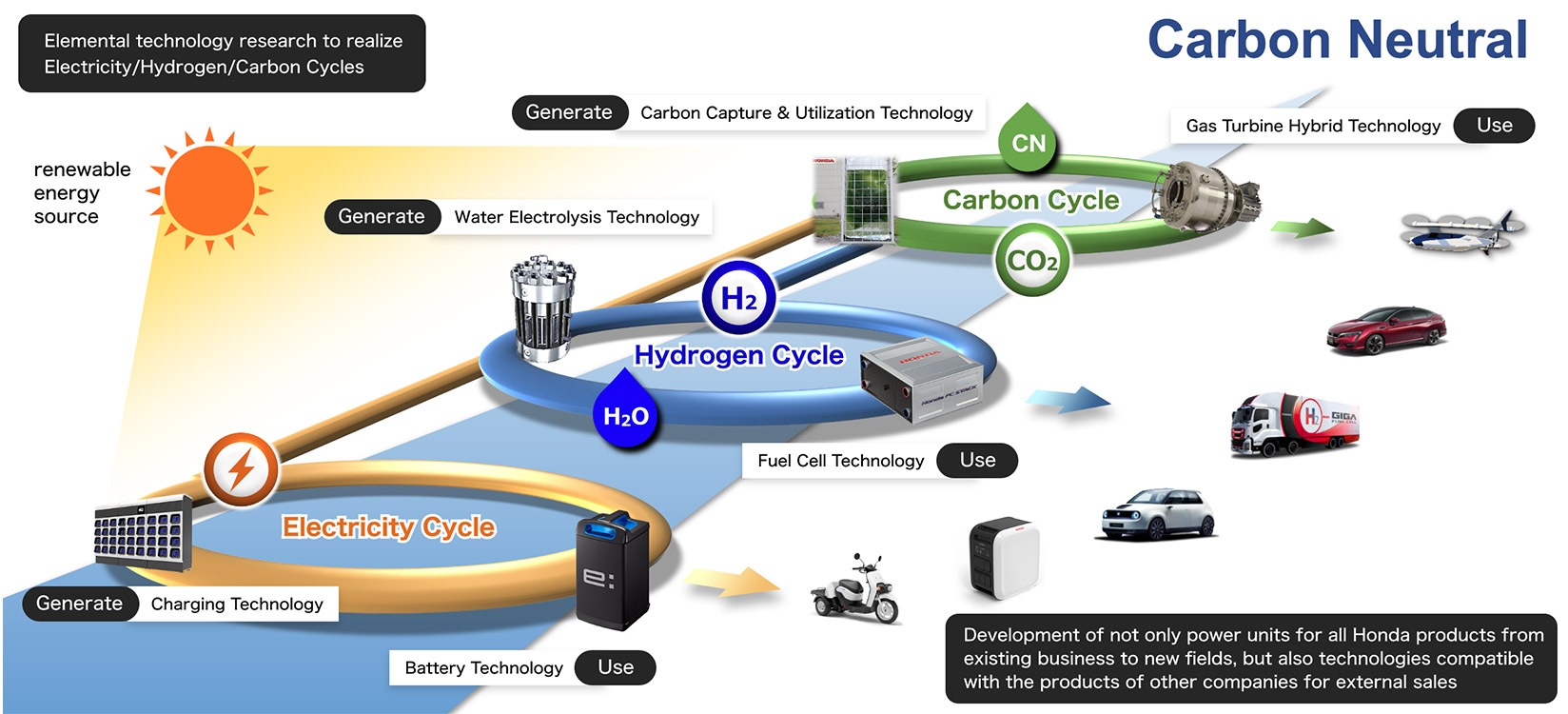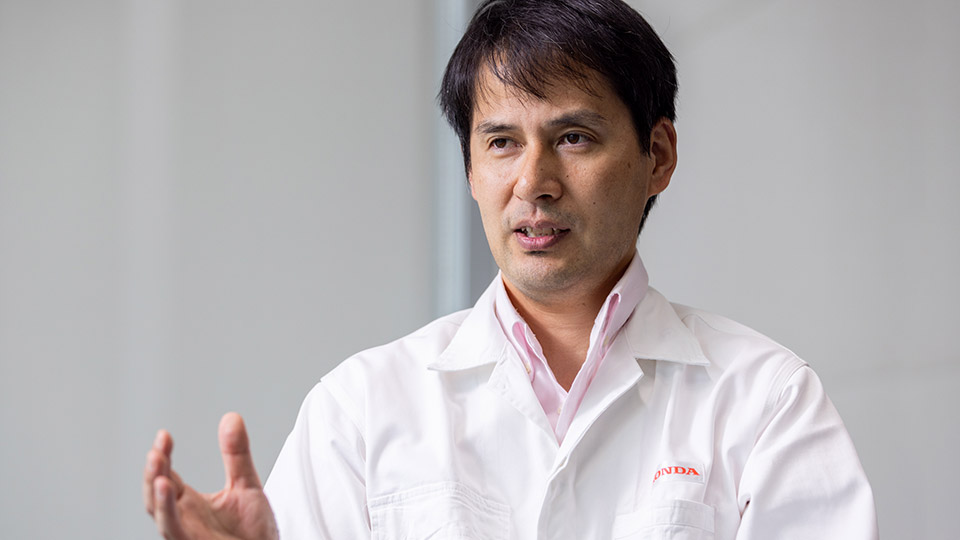

The next-generation batteries that will change EVs toward a carbon-neutral society!
Honda’s research on an all-solid-state battery
Development Story
Honda is striving to realize carbon neutrality for all products and corporate activities Honda is involved in by 2050. Achievement of this goal is based on the assumption that we eliminate CO2 emissions from our mobility products.
EVs are one of the key approaches to achieving this goal. Although EVs already exist in the market, they are not yet fully popularized at this moment due to issues including limited range and high prices. To resolve such issues, battery performance must be significantly advanced.
To this end, Honda is working independently on the development of all-solid-state batteries. We are not merely trying to establish a lab-level technology. As an automaker, we are developing all-solid-state battery technology with an eye toward mass-production, which will enable us to install them to our vehicles and offer high-performance EVs to our customers at affordable prices.
What is an all-solid-state battery?
Striving for a safe and high-capacity battery with excellent output characteristics
Lithium-ion batteries for current EVs use liquid electrolytes. On the other hand, all-solid-state batteries feature solid electrolytes. By changing electrolytes from liquid to solid, batteries can achieve a variety of outstanding battery characteristics.
First, let’s look into the basics of how an all-solid-state battery works.
A battery generates electricity by generating a flow of ions and electrons between two electrodes.
A battery is a device that stores electricity by "charging" and uses that electricity by "discharging."
When an external power source is connected to a lithium-ion battery, an oxidation reaction occurs at the positive electrode (cathode), releasing lithium ions (Li+) and electrons (e-) from the cathode. Both lithium ions and electrons move to the negative electrode (anode) through the electrolyte and the circuit, respectively, and are stored to the anode as lithium. This is charging.
When a charged lithium-ion battery is connected to an external circuit, an oxidation reaction occurs at the anode. Lithium ions (Li+) released by the oxidation reaction move through the electrolyte and return to the cathode. Electrons (e-) released by the oxidation reaction return to the cathode through the external circuit. This is discharging.
■ Charge
■ Discharge
Shifting from liquid to solid electrolyte enables a safer battery with higher capacity and better output characteristics.
Existing lithium-ion batteries use a liquid electrolyte, which is more prone to induce chemical reactions and has excellent ion conductivity. Due to the characteristics of liquid electrolytes, substances other than lithium ions also react and cause side reactions, which makes the materials for electrodes and other parts of the battery more susceptible to deterioration. Moreover, liquid electrolytes are organic solvents and flammable, therefore preventative measures are required against leakage. In addition, a separator must be placed in the middle to prevent the direct contact between cathode and anode which causes a short-circuit. The separator is sensitive to both heat and cold, limiting the operating temperature range of the battery. Although lithium-ion batteries offer excellent performance based on current standards, they still require various considerations, including the above-mentioned factors.
In 2011, a solid electrolyte with ionic conductivity higher than that of liquid electrolytes was discovered, and research on all-solid-state batteries began. Compared to liquid electrolytes, solid electrolytes are more chemically stable and less prone to unexpected side reactions, thus battery materials are less prone to degradation. Also, there is no risk of electrolyte leakage. Moreover, since the solid electrolyte also serves as a separator, there is no physical contact between the cathode and anode, and the battery can operate even at high temperatures. This expanded the range of choices for electrode materials, including materials that could not be used in conventional lithium-ion batteries, and enabled a high-voltage, high-capacity battery in a smaller space.
Lithium-ion battery

All-solid-state battery

Shifting from liquid to solid electrolyte enables a safer battery with higher capacity and better output characteristics.
Existing lithium-ion batteries use a liquid electrolyte, which is more prone to induce chemical reactions and has excellent ion conductivity. Due to the characteristics of liquid electrolytes, substances other than lithium ions also react and cause side reactions, which makes the materials for electrodes and other parts of the battery more susceptible to deterioration. Moreover, liquid electrolytes are organic solvents and flammable, therefore preventative measures are required against leakage. In addition, a separator must be placed in the middle to prevent the direct contact between cathode and anode which causes a short-circuit. The separator is sensitive to both heat and cold, limiting the operating temperature range of the battery. Although lithium-ion batteries offer excellent performance based on current standards, they still require various considerations, including the above-mentioned factors.
Lithium-ion battery

In 2011, a solid electrolyte with ionic conductivity higher than that of liquid electrolytes was discovered, and research on all-solid-state batteries began. Compared to liquid electrolytes, solid electrolytes are more chemically stable and less prone to unexpected side reactions, thus battery materials are less prone to degradation. Also, there is no risk of electrolyte leakage. Moreover, since the solid electrolyte also serves as a separator, there is no physical contact between the cathode and anode, and the battery can operate even at high temperatures. This expanded the range of choices for electrode materials, including materials that could not be used in conventional lithium-ion batteries, and enabled a high-voltage, high-capacity battery in a smaller space.
All-solid-state battery

■ Key features and advantages of
all-solid-state batteries

Developing products, not technologies.
Envisioning mass-production
Mass-produced all-solid-state batteries are not yet available in the market, and therefore there is flexibility in terms of production methods.
It is possible to develop a small battery while focusing on the performance of materials rather than restrictions of mass-production methods; however, for commercialization, it is important to develop batteries while envisioning future mass-production methods, which will enable our batteries to meet the requirements for each model such as size and cost.
The size and structure of electrodes and a specific stamping method required for all-solid-state batteries affect each other in terms of performance, cost, and quality. Therefore, we are conducting research to achieve compatibility between material specifications and production method specifications for batteries of a certain size.
For the earliest possible adoption to our products, we envision mass-production methods from the early stage of the development.
When we think of installing our all-solid-state batteries to our vehicles, we can determine the optimal size of the battery to be placed in the space under the floor. Moreover, in order to meet requirements which determine the value of the vehicle, such as range, cabin space and dynamic performance, we set preconditions and/or targets in terms of the battery structure, materials and production methods. By factoring the production process into the research from the initial stage, it becomes easier to select materials and shorten the development period.
Honda has been taking the initiative in developing our own all-solid-state batteries and establishing technologies necessary for the mass-production of all-solid-state batteries that can be installed to our vehicles. Based on our initial achievements, we will move on to the research process to further advance battery performance, which will be accelerated with the aim to apply our all-solid-state batteries to models introduced to market in the second half of the 2020s.
Difficulties in producing all-solid-state batteries that do not exist for liquid electrolyte batteries
Existing lithium-ion batteries have the advantage of a liquid electrolyte, which makes it easier for ions to flow back and forth between the anode and cathode. On the other hand, all-solid-state batteries feature a solid electrolyte, which requires certain fabrication techniques and material selections to make it easier for ions to flow. This includes stamping to increase the density of the inside of the solid electrolyte and performing special processing techniques and selecting specific materials to ensure excellent interfacial contact between the electrodes and the electrolyte.
Image of the structure of all-solid-state battery

■ Image of the inside structure of
the solid electrolyte

■ Image of the degree of interfacial
contact between the electrodes and
the solid electrolyte

Roll-pressing will enable both high battery performance and high manufacturing productivity.
Stamping is necessary to increase the degree of interfacial contact between the electrolyte and the electrodes. However, applying too much pressure may damage the microstructure of the materials and lower the battery performance and/or damage other elements of the battery. Especially because there are still many unknowns in the field of all-solid-state battery technologies, and there is no established benchmark for the correlation between the density of electrolyte and battery performance, development which focuses on both the realistic needs of mass-production and battery performance is extremely valuable. Recognizing the high potential of a roll press, which will lead to high production line speed, Honda has been amassing know-how in roll press techniques with an aim to establish production technology of all-solid-state batteries.
■ Video of the all-solid-state battery cell prototyping process
■ All-solid-state battery cell prototyping process

■ Passion and commitment toward the development of an all-solid-state battery
Honda conducts human-centered development, giving first priority to the value we offer to our customers.
In general development, we build technological elements from the ground up, and after completing development to confirm product functionality and performance, we move on to development for mass production. On the other hand, for the development of all-solid-state batteries, from the very beginning, we have been working on the assumption that we will mass-produce these batteries as we have been conscious of addressing social issues as quickly as possible with our new batteries.
That is why we first determine the battery shape suitable for vehicle installation and then pursue optimal materials and mass-production methods to achieve both excellent performance and cost.
In reality, it is often difficult to know whether our development will produce good results unless we actually build it once, and many issues only become evident after we actually build it. This approach is what we call the “Genba, Genbutsu,” which means to “develop at the real spot with understanding of the real situation.” By repeating trial and error, we set the exact targets we need to achieve to realize the value we want to offer to our customers. Then, we apply our technologies and attain our targets without compromise. We believe that this approach to the development reflects the unique characteristics of Honda. Moreover, because the battery is a crucial component of battery electric vehicles (EV), it is important for Honda to develop it while incorporating our own thoughts and desires as a company that actually makes EVs.
Honda is striving to realize carbon neutrality for all products and corporate activities Honda is involved in by 2050. Just like our long history of research into fuel cells as an automaker, Honda has a proven track record of Monozukuri (manufacturing) through which we not only develop technologies, but also commercialize them as our own products. By levering such strengths of Honda, we will strive to achieve mass-production of our all-solid-state batteries as quickly as possible. As the first step, our demonstration line for the production of all-solid-state batteries will become operational in 2024, where we will work toward the establishment of mass-production technologies. Then, leveraging such initial technologies as a foothold, we will continue to advance our all-solid-state batteries.
In order to realize carbon neutrality, Honda is positioning the all-solid-state battery as one of the key technologies and is working sincerely on its development with an eye toward the earliest possible start of mass-production.

-

Kenta Umetsu
All-solid-state battery development leader,
materials and process
Innovative Research Excellence
Honda R&D Co., Ltd.
- Honda Technology
- All-solid-state battery technology